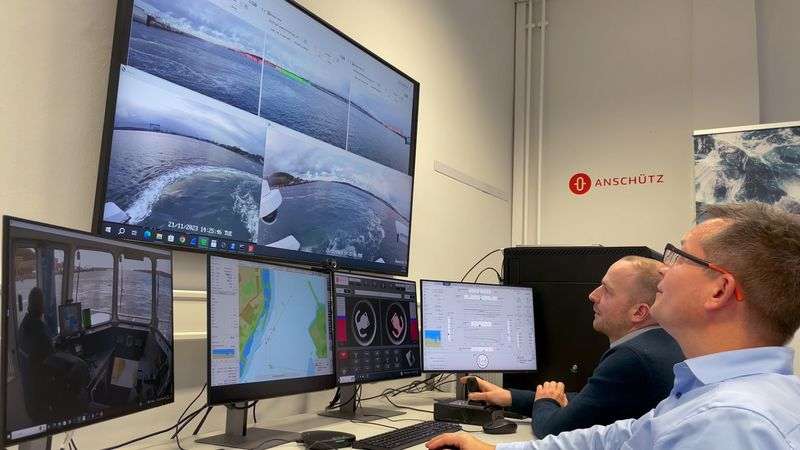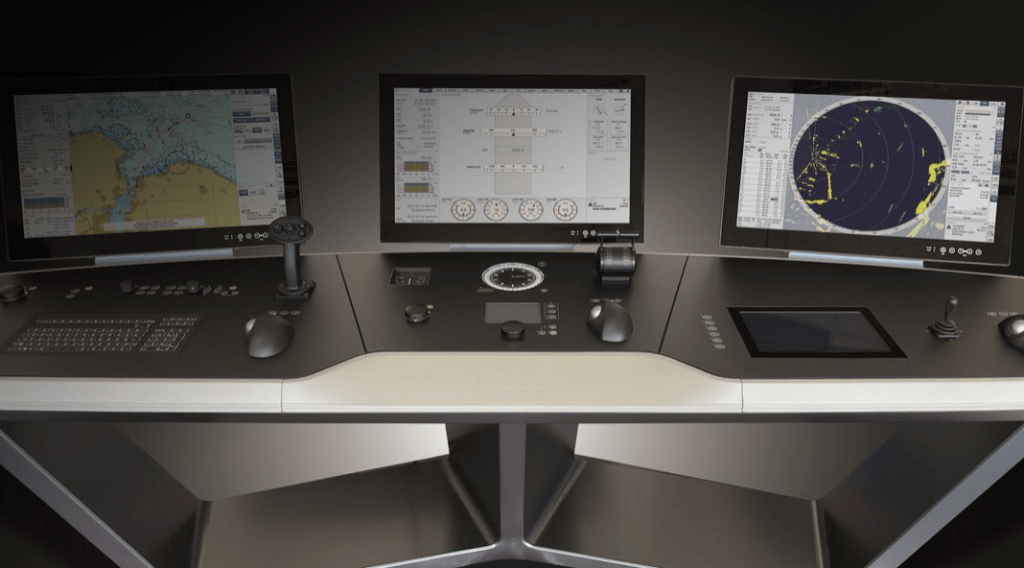
As an expert in navigation and bridge systems, Anschütz is working on solutions for (partially) autonomous systems and assistance systems onboard ships that support navigators, reduce errors and, thus, make shipping safer and more efficient overall.
As part of the Clean Autonomous Public Transportation Network (CAPTN) initiative, research into this issue has made great progress in 2023. In the Remote Operating Centre (ROC) which is set up on land at Anschütz, the MV Wavelab is monitored. The Wavelab is a research catamaran that is operating on a maritime test field on the Kiel Fjord in Germany.
Part of the ROC is a complete digital twin with all the data provided by the various existing and experimental sensors and systems on board the Wavelab. Remote control and manoeuvring of the ship with full access to the sensor data and the navigation, steering and propulsion systems has been successfully demonstrated under various environmental conditions.

“So far, our focus has been on finding out what information needs to be presented to users and how, so that they can monitor and remotely control a ship safely and efficiently”, said Daniel Sommerstedt, Head of Research Projects at Anschütz. “Our aim now is to increase the level of automation of the systems on board so that we can ideally demonstrate the first autonomous driving tests in Kiel by the end of 2024.”
The automation of the Wavelab’s control and drive systems is currently being driven forward. The Electronic Chart Display and Information System (ECDIS) and autopilot interact with each other to provide remote control using heading control, as well as largely autonomous driving with the help of track control and speed control. In order to be able to dock automatically in the future, manoeuvrability at low speeds in particular is to be improved in further research trips.
“Additional assistance is also important. In our Remote Operating Centre, we process data from new sensors and develop new functions that we can run on our bridge platform. We can then enrich the overall maritime picture with additional information, including clear recommendations for the navigators”, said Sommerstedt.
The assistance systems to be developed and tested in the next project phase in 2024 include collision avoidance scenarios calculated on the basis of artificial intelligence and rule- and model-based approaches. A maritime situation analysis in accordance with IMO collision avoidance regulations is to be created using tracks and own ship information. First, a recommendation is to be presented to the user as to whether the course should be maintained, or an evasive manoeuvre is necessary. Then, the system will calculate and display trajectories that can be automated in the long term.
In the further course of the project, various sensors will be analysed in defined scenarios to determine the extent to which they improve situation assessment and, thus, simplify safe navigation and steering. This involves, for example, radar, video and light detection and ranging sensors, devices for bearings and the determination of distances, as well as systems for the automatic detection and classification of objects.
“The research projects within the CAPTN initiative enable us to design and test new ship sensors and systems with partners from the industry and science in a unique real maritime test field for autonomous ships”, said Sommerstedt. “We are driving forward innovations in our navigation systems that are ready for approval and with which we can make shipping safer, more efficient and, for example, more flexible in terms of manning concepts.”
CAPTN‘s vision is to develop autonomous, safe and sustainable public transport systems. The aim of CAPTN is to connect the eastern and western shores of the Kiel Fjord with autonomous, low-emission passenger ferries. A network of leading companies and universities is developing and researching the necessary technologies in a series of individual projects funded by the German Federal Ministry for Digitalisation and Transport.
As part of the CAPTN Fjord Area I research project, the research catamaran Wavelab was built, the largest research vessel for autonomous shipping in Germany according to its class designation. The navigational basis of the Wavelab is the SYNAPSIS NX Integrated Navigation System from Anschütz. This includes radar equipment, ECDIS, intelligent data and alarm management, as well as autopilot systems. The system also integrates optical sensors and closed-circuit television cameras, and enables data exchange with the ROC at Anschütz, including information on routes, obstacles and destinations, to make remote monitoring and the autonomous navigation trials possible.
In the Fjord 5G research project, the project partners have installed an extremely powerful infrastructure for maritime data communication based on a 5G mobile network and a high-performance WiFi-6 network on the Kiel Fjord.
With the follow-up project CAPTN Fjord Area II, the next phase has already begun. It will enable extensive research and development efforts regarding autonomous shipping on the Kiel Fjord in the long term. Further research projects are currently being planned as part of the CAPTN initiative.
Project partners include Anschütz GmbH, Addix GmbH, the University of Applied Sciences of Kiel, the Christian-Albrechts-Universität zu Kiel (CAU), FuE-Zentrum FH Kiel GmbH, and the Science Center (WiZe) Kiel GmbH.



Be the first to comment